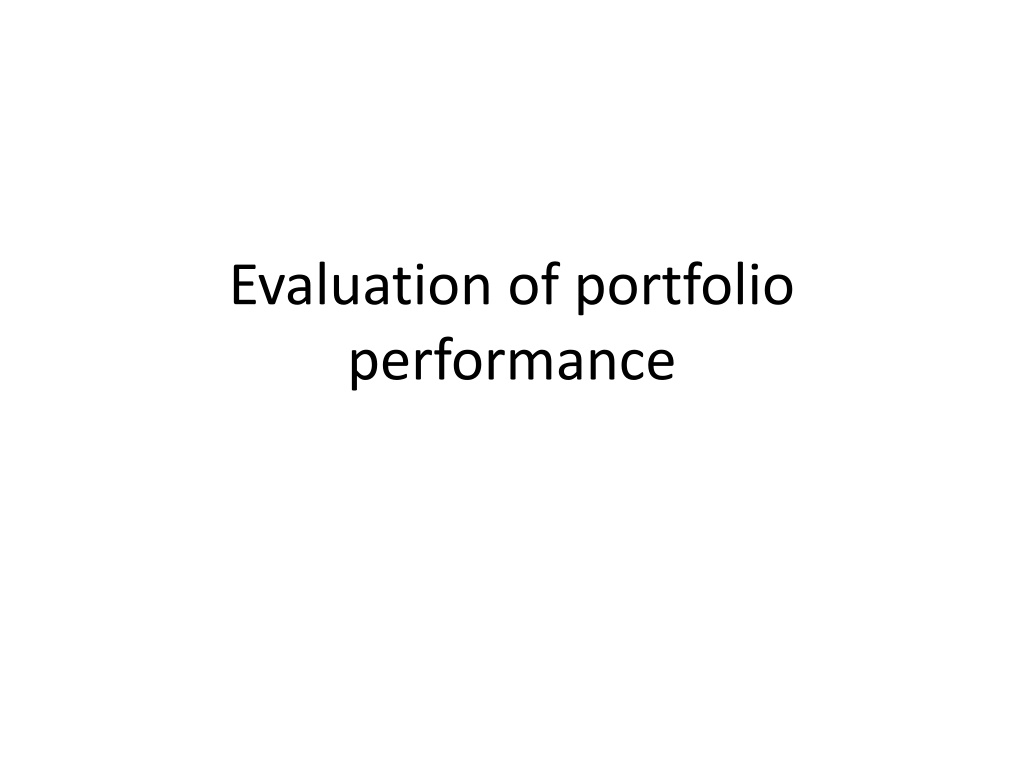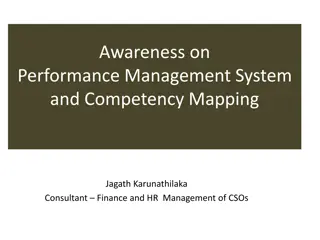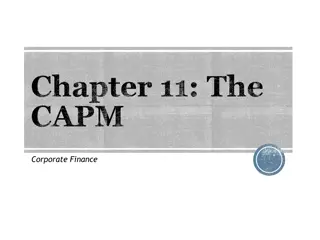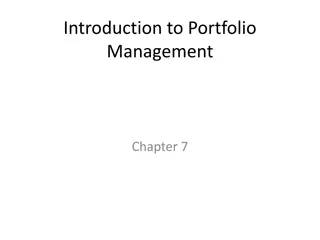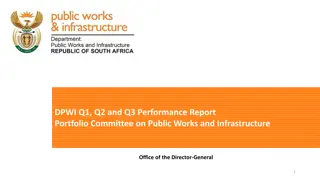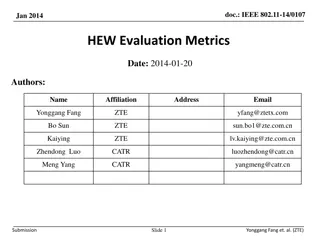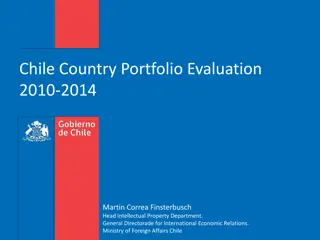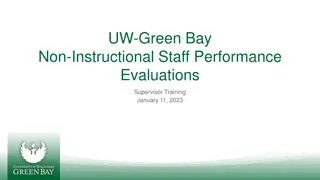Portfolio Performance Evaluation Techniques
Portfolio managers need to focus on deriving above-average returns while managing risk effectively through market timing and security selection. Diversification is crucial to eliminate unsystematic risk, and evaluation techniques like Treynor, Sharpe, Jensen measures help assess risk-adjusted returns. Early techniques lacked explicit risk adjustments, emphasizing the importance of evolving evaluation methods.
Download Presentation

Please find below an Image/Link to download the presentation.
The content on the website is provided AS IS for your information and personal use only. It may not be sold, licensed, or shared on other websites without obtaining consent from the author.If you encounter any issues during the download, it is possible that the publisher has removed the file from their server.
You are allowed to download the files provided on this website for personal or commercial use, subject to the condition that they are used lawfully. All files are the property of their respective owners.
The content on the website is provided AS IS for your information and personal use only. It may not be sold, licensed, or shared on other websites without obtaining consent from the author.
E N D
Presentation Transcript
Evaluation of portfolio performance
What is required of a portfolio manager? 1. Ability to derive above average returns for a given risk class. Superior timing Superior security selection
Market timing Predict the peaks or troughs in the market and adjust portfolio composition to anticipate these trends Hold diversified high-beta stocks through rising markets Bigger gains in rising market Low-beta stocks and money market instruments in declining markets smaller losses in losing market
Security selection Select undervalued stocks or bonds for a given risk class. Even without superior market timing, produce above-average risk-adjusted returns.
What is required of a portfolio manager? 2. Ability to diversify the portfolio completely to eliminate all unsystematic risk, relative to the portfolio s benchmark. Market rewards only systematic risk.
What is required of a portfolio manager? Both requirements of the portfolio manager are important because Some portfolio evaluation techniques take into account one requirement but not the other. Other techniques implicitly consider both factors but do not differentiate between them.
Early performance measurement techniques Portfolio evaluation before 1960 rate of return within risk classes Peer group comparisons no explicit adjustment for risk difficult to form comparable peer group
Composite Portfolio Performance Measures Combine risk and return performance into a single value. 1. Treynor portfolio performance measure 2. Sharpe portfolio performance measure 3. Jensen portfolio performance measure 4. Information ratio performance measure
Treynor Portfolio Performance Measure Treynor recognized two components of risk Risk from general market fluctuations Risk from unique fluctuations in the securities in the portfolio His measure of risk-adjusted performance focuses on the portfolio s undiversifiable risk: market or systematic risk
Treynor Portfolio Performance Measure To identify risk due to market fluctuations, he introduced characteristic line Measures the relationship between the returns to a managed portfolio and the market portfolio Slope of this line is the portfolio s beta coefficient A higher slope (beta) characterizes a portfolio that is more sensitive to market returns and has greater market risk.
Treynor Portfolio Performance Measure ( i RFR R ) = T i The numerator is the risk premium The denominator is a measure of risk The expression is the risk premium return per unit of risk
Treynor Portfolio Performance Measure The expression is the risk premium return per unit of risk Risk averse investors prefer to maximize this value Later T value indicates a better portfolio for all investors, regardless of their risk preference. This assumes a completely diversified portfolio leaving systematic risk as the relevant risk
Treynor Portfolio Performance Measure Comparing a portfolio s T value to a similar measure for the market portfolio indicates whether the portfolio would plot above the SML Calculate the T value for the aggregate market as follows: ( m m T ) R RFR = m
Treynor Portfolio Performance Measure Comparison to see whether actual return of portfolio G was above or below expectations can be made using: ( ) RFR R E G = ( ) + R RFR i m
Sharpe Portfolio Performance Measure Risk premium earned per unit of risk R RFR i = S i i
Treynor versus Sharpe Measure Sharpe uses standard deviation of returns as the measure of risk Risk premium earned per unit of total risk. Treynor measure uses beta (systematic risk) Sharpe therefore evaluates the portfolio manager on the basis of both rate of return performance and diversification
Treynor versus Sharpe Measure Treynor s performance measure uses SML Sharpe s performance measure uses CML The methods agree on rankings of completely diversified portfolios Produce relative not absolute rankings of performance
Jensen Portfolio Performance Measure Also based on CAPM Expected return on any security or portfolio is ( ) RFR R E j + = ( ) E R RFR j m Where: E(Rj) = the expected return on security RFR = the one-period risk-free interest rate j= the systematic risk for security or portfolio j E(Rm) = the expected return on the market portfolio of risky assets
Jensen Portfolio Performance Measure Rjt-RFRt= j+ j[Rmt-RFRt]+ejt Alpha indicates the portfolio s superior or inferior in her investment ability. A superior manager has a significant positive alpha A inferior manager has a significant negative alpha Performance of a portfolio manager with no forecasting ability but not clearly inferior equals that of a na ve buy and hold strategy.
The Information Ratio Performance Measure Appraisal ratio measures average return in excess of benchmark portfolio divided by the standard deviation of this excess return = R R ER j j = b IR j ER ER Rb = Average return for the benchmark portfolio during the period ER = Standard deviation of the excess return during the period
ER j ER Numerator can be considered as the investor s average alpha if the average return to the benchmark is taken to be the expected return for the actively managed portfolio. Denominator is the tracking error of the portfolio and it is the cost of active management
The Information Ratio Performance Measure To interpret IR, the mean return differential in the numerator represents the investor s ability to use her talent and information to generate a portfolio return that differs from that of the benchmark against which the performance is being measured.
Potential Bias of One-Parameter Measures positive relationship between the composite performance measures and the risk involved alpha can be biased downward for those portfolios designed to limit downside risk
Components of Investment Performance Fama suggested overall performance, which is its return in excess of the risk-free rate Portfolio Risk + Selectivity Further, if there is a difference between the risk level specified by the investor and the actual risk level adopted by the portfolio manager, this can be further refined Investor s Risk + Manager s Risk + Selectivity
Components of Investment Performance The selectivity measure is used to assess the manager s investment prowess
Components of Investment Performance The market line then becomes a benchmark for the manager s performance ( ) = Selectivit y R R a x a Ra = Actual return on the portfolio being evaluated Rx( a) = Return on the combination of the riskless asset and the market portfolio M that has risk x. Equal to a, the risk of the portfolio being evaluated.
Components of Investment Performance The selectivity component can be broken into two parts gross selectivity is made up of net selectivity plus diversification Selectivit y Diversific ation ( ) ( ( ) ) ( ) = + Selectivit Net y R R R R R a x a x a x a
Components of Investment Performance Assuming the investor has a target level of risk for the portfolio equal to T, the portion of overall performance due to risk can be assessed as follows: = + Risk Manager' Risk s Investor' Risk s ( ) ( ) ( ) ( ) = + R RFR R R R RFR x a x a x T x T
Relationship Among Performance Measures Treynor Sharpe Jensen Information Ratio Fama net selectivity measures Highly correlated, but not perfectly so
Performance Attribution Analysis Allocation effect ( ( ) ( ) = ) ( W W R R i ai bi bi b Selection effect ) = W R R i ai ai bi Wai, Wbi = investment proportions of the ith market segment (e.g. asset class, industry group) in the active manager s portfolio and the benchmark policy portfolio Rai, Rbi = Investment return to the ith market segment in the active manager s portfolio and the benchmark portfolio, respectively. Rb = total return to the benchmark portfolio
Measuring Market Timing Skills Tactical asset allocation (TAA) Attribution analysis is inappropriate indexes make selection effect not relevant multiple changes to asset class weightings during an investment period Regression-based measurement
Factors That Affect Use of Performance Measures Market portfolio difficult to approximate Benchmark error can effect slope of SML can effect calculation of Beta greater concern with global investing problem is one of measurement Sharpe measure not as dependent on market portfolio
Benchmark Portfolios Performance evaluation standard Usually a passive index or portfolio May need benchmark for entire portfolio and separate benchmarks for segments to evaluate individual managers
Characteristics of Benchmarks Unambiguous Investable Measurable Appropriate Reflective of current investment opinions Specified in advance
Building a Benchmark Specialize as appropriate Provide value weightings Provide constraints to portfolio manager
